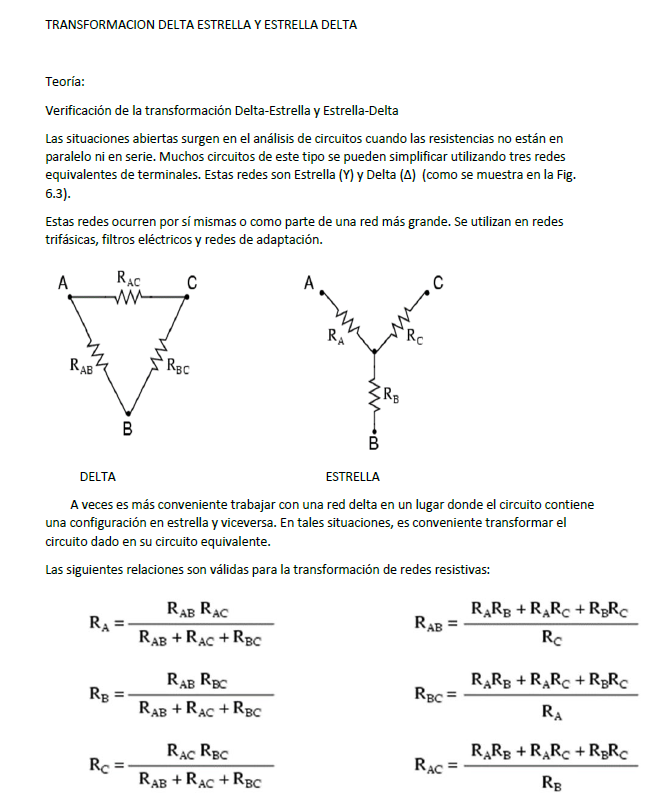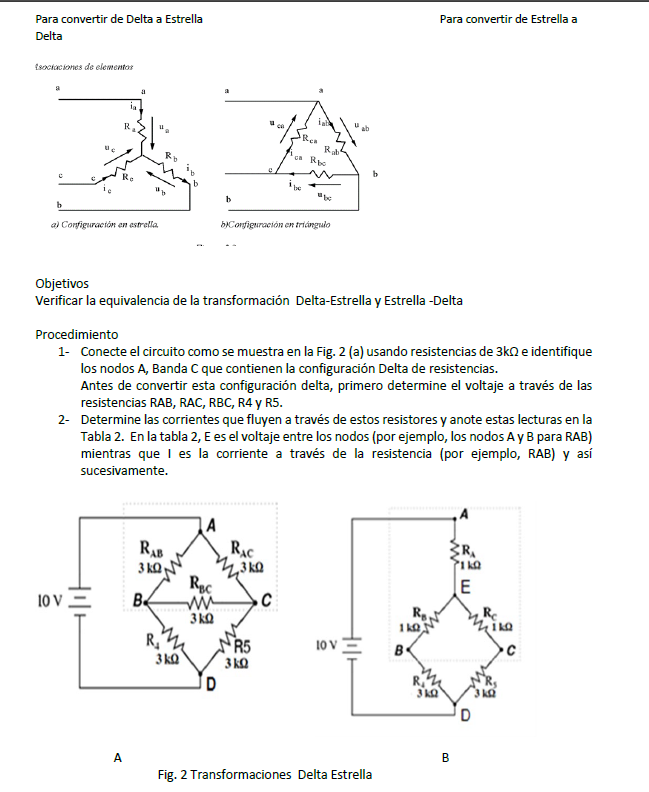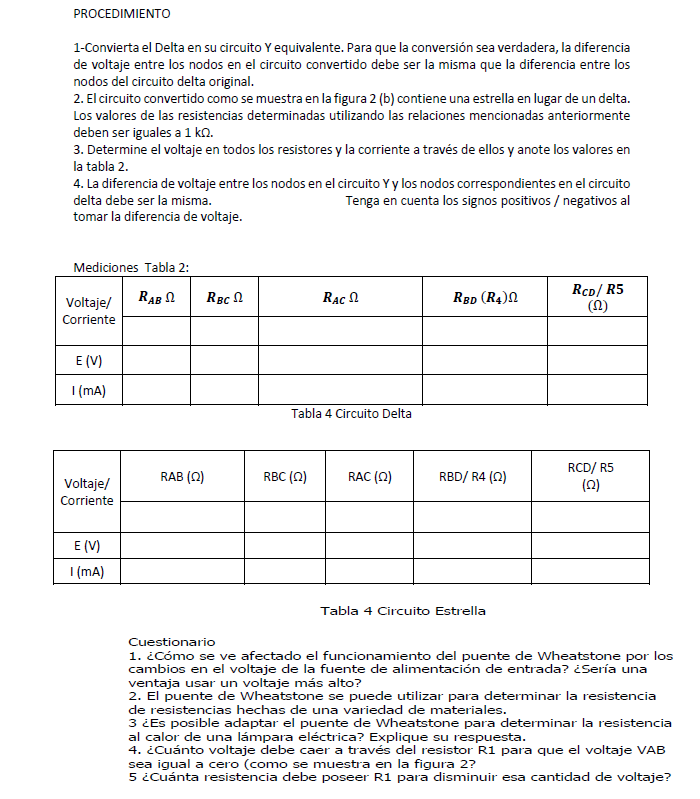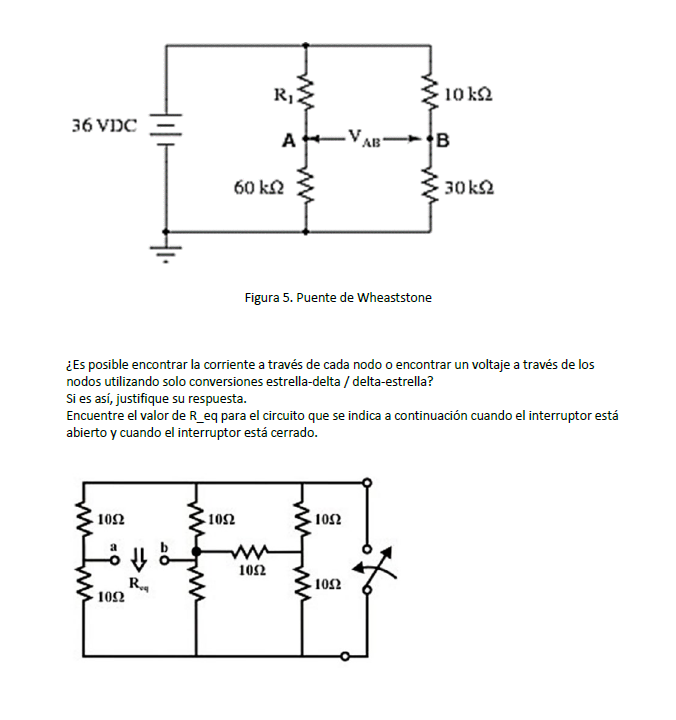¡Tu solución está lista!
Nuestra ayuda de expertos desglosó tu problema en una solución confiable y fácil de entender.
Mira la respuestaMira la respuesta done loadingPregunta: TRANSFORMATION DELTA STAR AND DELTA STAR Theory: Verification of the transformation Delta-Star and Star-Delta Open situations arise in circuit analysis when resistors are neither in parallel nor in series. Many such circuits can be simplified using three equivalent networks of terminals. These networks are Star (Y) and Delta (Δ) (as shown in Fig. 6.3). These
TRANSFORMATION DELTA STAR AND DELTA STAR
Theory:
Verification of the transformation Delta-Star and Star-Delta
Open situations arise in circuit analysis when resistors are neither in parallel nor in series. Many such circuits can be simplified using three equivalent networks of terminals. These networks are Star (Y) and Delta (Δ) (as shown in Fig. 6.3).
These networks occur by themselves or as part of a larger network. They are used in three-phase networks, electrical filters and adaptation networks.Sometimes it is more convenient to work with a delta network in a place where the circuit contains a star configuration and vice versa. In such situations, it is convenient to transform the given circuit into its equivalent circuit.
The following relations are valid for the transformation of resistive networks:objectives
Check the equivalence of the transformation Delta-Star and Star-Delta
Procedure
1- Connect the circuit as shown in Fig. 2 (a) using 3kΩ resistors and identify the nodes A, Band C that contain the Delta configuration of resistors.
Before converting this delta configuration, first determine the voltage across resistors RAB, RAC, RBC, R4, and R5.
2- Determine the currents flowing through these resistors and record these readings in Table 2. In Table 2, E is the voltage between the nodes (for example, nodes A and B for RAB) while I is the current through resistor (eg RAB) and so on.PROCESS
1-Convert the Delta into its equivalent AND circuit. For the conversion to be true, the voltage difference between the nodes in the converted circuit must be the same as the difference between the nodes in the original delta circuit.
2. The converted circuit as shown in Fig. 2(b) contains a star instead of a delta. The values of the resistances determined using the relationships mentioned above should be equal to 1 kΩ.
3. Determine the voltage across all resistors and the current through them and record the values in Table 2.
4. The voltage difference between the nodes in the Y circuit and the corresponding nodes in the delta circuit must be the same. Note the positive/negative signs when taking the voltage difference.Quiz 1. How is the operation of the Wheatstone bridge affected by changes in input power supply voltage? Would it be an advantage to use a higher voltage?
2. The Wheatstone bridge can be used to determine the resistance of resistors made from a variety of materials.
3 Is it possible to adapt the Wheatstone bridge to determine the heat resistance of an electric lamp? Explain your answer.
4. How much voltage must drop across resistor R1 for the voltage VAB to be equal to zero (as shown in Figure 2)?
5 How much resistance must R1 have to drop that amount of voltage?
Is it possible to find the current through each node or to find a voltage across the nodes using only star-delta / delta-wye conversions?
If so, justify your answer.
Find the value of R_eq for the circuit given below when the switch is open and when the switch is closed.- Esta es la mejor manera de resolver el problema.SoluciónTe mostramos cómo abordar esta pregunta.
Este consejo generado con IA está basado en la solución completa de Chegg. ¡Regístrate para ver más!
To determine the voltage across resistors , , , , and , measure the potential difference across each resistor using a voltmeter before converting the Delta configuration.


Estudia mejor, ¡ahora en español!
Entiende todos los problemas con explicaciones al instante y pasos fáciles de aprender de la mano de expertos reales.



